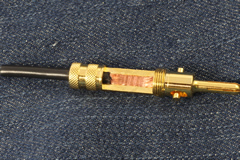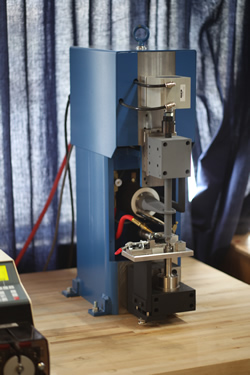Ultrasonic Welding and BJC Speaker Cable

In June, 2010, Blue Jeans Cable introduced an innovation in home audio cabling: welded speaker cables. Thanks to an ultrasonic welder from Sonobond Corporation and our own custom-designed weldable banana plugs, spade lugs and pin terminals, we are now able to produce speaker cable assemblies with the best possible mechanical and electrical junction between cable and connector: a weld.
Before going into detail, a clarification is probably in order. We've often seen people refer to "welded" connections when they mean "soldered," and we want to assure you that that's not the case here; we know very well the difference between soldering (where two metal surfaces are joined by heating them and flowing a low-melting point metal into the junction between them) and welding (where two metal surfaces are fused directly together), and while we do solder numerous other types of cable assemblies, these connections are welded. The copper speaker wire enters the back of the banana plug and is fused directly to the gold-plated brass surface of the banana plug, in a bond of remarkable strength and low electrical resistance.
Sparks Flying?
Anyone acquainted with the sorts of welding we see in normal daily life will think this is a bit odd. Most welding is done either with a gas flame or with a high-current flow of electricity, and involves considerable heat. Welding speaker cables to banana plugs in those ways would be well nigh impossible, because the heat required is so great that it would destroy the insulation on the cable, and the heat conductivity of the banana plug is so high that it would be very hard to make the weld without melting and badly distorting the plug. The connection point at the weld would be superb, but with the insulation burned off of the wire and the plug now possibly too misshapen to go into a binding post, it wouldn't be a very useful product.
So, How is it Done?
There are other ways to pump a lot of energy into a metal-to-metal joint besides the conventional method of just heating it up, and one of these is through ultrasonic vibrations. By applying high-energy vibration to metal parts, one can break down the structure of the metal without raising it to high temperatures--pressure and vibration "melt" the metal without reaching the melting temperature, and surfaces can be fused together at close to room temperature.

We first saw this process performed by a remarkable company out of West Chester, Pennsylvania, called Sonobond Ultrasonics. Sonobond makes ultrasonic welders for small terminal welding, wire splicing, and a variety of other applications at its factory in West Chester, and its demonstrations at wire-harness trade shows (yes, we know; a wire-harness trade show sounds like a pretty exciting thing) are something to behold. One moment, the operator of the machine is holding a piece of stranded wire and a terminal, completely separate from one another. He puts the wire and terminal into the machine, hits a footpedal, and a second later, pulls the terminal out. The wire is now fused to the terminal, and yet the assembly can immediately be dropped into the palm of one's hand--it's just a bit warm. The experience of seeing it done for the first time is so strange that it seems like it must be some sort of sleight-of-hand routine--the first impression is that what has just happened must be physically impossible.
Why Welded Speaker Cable?
Ultrasonic welding clearly could be used to attach terminals to speaker cable, if one could have a terminal made that offered a clean weld surface and if one were willing to invest in the equipment to do it--but why bother? Well, we have long been unhappy with conventional methods for attaching banana plugs to speaker cable, for a couple of reasons.
First, from an electrical integrity standpoint, it's best to have as few surface-to-surface connections in any electrical line as possible. Every time surfaces are held together to make electrical contact, it provides a potential point for failure. For this reason, we have long favored bare-wire termination of speaker cable, because bare-wire termination means only two surface-to-surface connections (amp binding post to wire and speaker binding post to wire) rather than four (amp binding post to banana, banana to wire, wire to banana, banana to speaker binding post). The weakest of these junctions is the joint of bare wire either to a binding post or to a banana plug, as these connections, held together only by screw tension, are vulnerable to loosening through vibration and to corrosion--the banana-to-binding post connections, by contrast, use non-corrosive plating such as gold to prevent oxidation from compromising the connection. Welding the banana to the wire eliminates the weak point in the speaker connection; even if the connection were to corrode, it would corrode on the outer surfaces and not within the weld itself, and no amount of vibration (short of another trip through an ultrasonic press) will break the weld loose.
Second, the mechanical integrity of conventional banana plug connections just isn't very good. Wire held into banana plugs by compression screw or setscrew methods can be pulled out of those plugs with a good hard pull, and while this isn't likely to happen with ordinary handling, it means that trying to pull terminated speaker cables through walls and conduits is very chancy--and can end with the banana plugs lost in, and obstructing, a conduit. With welded speaker cables, it takes a considerable force to rip the plug from the cable; a 12 AWG wire with a welded banana plug will not pull apart without around 130 pounds of force, and of course if that force is distributed across multiple wires, the strength only multiplies.
These problems might be solved by going to soldering--but the strength of a solder joint isn't as good as that of a weld, and although soldering doesn't involve the same levels of heat as are required for welding, the heat required to solder a large wire to a heavy terminal like a banana plug without the risk of an unreliable cold-solder joint is still enough to cause a lot of insulation melt-back on the speaker wire. Add to that the fact that soldering these large terminals is fairly labor-intensive work, and it just doesn't add up to a good solution.
The downsides of welding, on the other hand, were manageable. An ultrasonic welder is an expensive piece of gear, and the connectors needed a redesign to maximize the weld surface area and to open that area up for the weld head, but after some months of preparation and a bit of investment, the plugs and the welder are here and ready to weld. The result is a speaker cable with the best physical durability and electrical integrity of any speaker cable on the market, but without the crazy pricing of the boutique cable companies.
American Cable, American Technology, American Assembly
All assembly of our welded speaker cables is done here in our shop in Seattle, Washington. Our primary speaker cable stocks come from Belden Wire and Cable in Richmond, Indiana, and the welder is, as mentioned above, made by Sonobond in its factory in West Chester, PA. Blue Jeans Cable is committed to keeping manufacturing jobs in the USA, and whenever we can source and assemble products and equipment here, that's how we prefer to work. The price is a bit higher than you'll find on some of the many generic Chinese products available elsewhere, but so is the quality of manufacture--this is the best-engineered, best-built speaker cable you will find anywhere, at any price.


